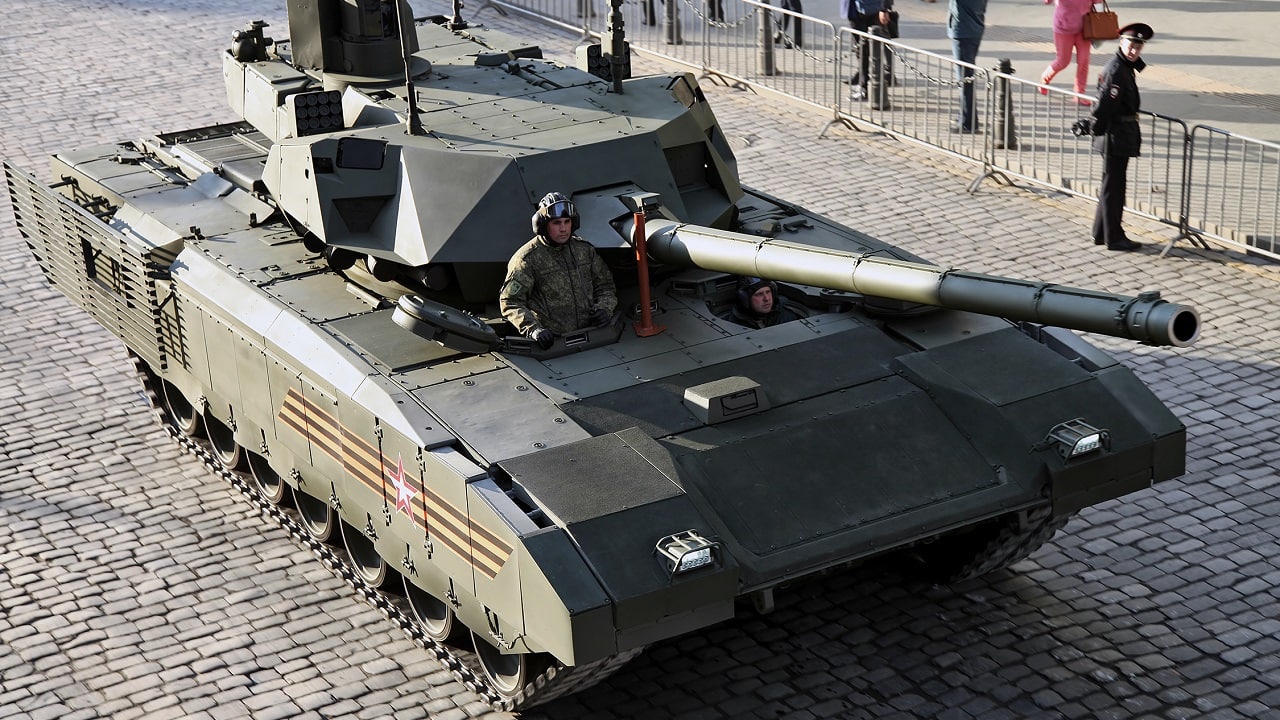Where is Russia’s T-14 Armata? Not in Ukraine – Notably absent in Russia’s so-called “special military operation” in Ukraine has been the T-14 Armata tank, but that’s probably for the best. Since launching the unprovoked and unwarranted invasion in February, hundreds of Russian tanks have been destroyed. Though the T-14 hasn’t been among the tanks lost, it has been a casualty in other ways.
It was reported this month that sanctions imposed on Moscow have stopped the planned serial production. It is the latest setback for a tank that was supposed to enter service several years ago.
The situation will likely not improve. As Forbes reported this month, since 2014 the UK paid some $30 billion for Russian oil and gas – enough money to enable Moscow to purchase 8,000 of the next-generation main battle tanks (MBTs).
Russian oil is still flowing to Western Europe, but the sanctions have been strong enough that production of the T-14 has been halted.
Meet the T-14 Armata
The Armata T-14 MBT was first demonstrated during the May 2015 Victory Parade in Moscow. It was just one component of the Armata heavy-tracked standardized platform, which serves as the basis to develop the main battle tank, an infantry fighting vehicle, an armored personnel carrier, and some other armored vehicles.
The next-generation T-14 was notable in that it featured fully digitized equipment, an unmanned turret and an isolated armored capsule for the crew.
Work on the Armata project began in 2010 when the Russian Ministry of Defence terminated work on “Object-195” – the T-95 program.
The entire Armata project was seen to be a huge technological leap from Soviet-era military hardware designs and from the ground up the T-14 is very much distinct from past Soviet/Russian tank platforms.
The outline of the tank, from its hull to its long and boxy turret, more closely resembles modern western tank turret designs, and is quite the departure from previous Soviet designs.
The T-14 Armata was also notable in that it featured seven road wheels instead of the six wheels that were commonplace on most previous Cold War Soviet and even modern Russian MBTs. It was also far more compartmentalized than even contemporary western tanks.
Unmanned Turret
Among the T-14’s innovative characteristics is its unmanned turret, which was developed to house a remotely controlled 125-millimeter 2A82-1M smoothbore main gun and fully automated loader.
Within the tank’s magazine, a total of 45 rounds of ammunition can be stored. The main gun is also designed to fire laser-guided missiles. In addition, the 2A82 125mm gun can even be upgraded to the 2A83 152mm gun, while the T-14 was also equipped with secondary weapons including the Kord 12.7mm or a PKTM 7.62mm machine gun.
The three-man crew – which includes the tank commander, driver/mechanic, and gunner are all housed in a crew compartment located in an armored capsule at the front portion of the hull, isolated from the automatic loader as well as the ammunition storage in the center of the tank. This was meant to provide increased survivability for the crew – and unlike other tanks, this Armata platform features an internal toilet (described as part of the internal “life support system”).
Each crew member also has his own hatch at the front of the tank, with the gunner positioned on the left, the gunner in the middle and the commander at the right.
Modular Design
The modular design of the T-14 also includes an advanced armor system, which consists of steel, ceramics, and composite materials. The tank’s forward section is designed with reactive armor, while the rear is fitted with bar armor to provide enhanced protection from anti-tank rocket-propelled grenades. To help ensure that the tank won’t need to actually rely on the armor to protect the crew in a fight, it is outfitted with multispectral sights with visible scope, thermal channels, and even laser rangefinders. The goal was to take out any potential threat before it could put the tank in the crosshairs.
According to Army Technology, the commander’s sight is mounted on top of the turret where it can provide a 360-degree field of view, whereas the gunner’s sight is fitted with a direct-vision periscope and a laser designator. In addition, wide-angle cameras are mounted to further enhance the situation awareness of the crew, while electro-optical/infrared (EO/IR) based laser warning receivers are provided to spot potential threats.
Another option for any tanker is to get out of a fight it can’t win. To accomplish that, the T-14 was designed to be powered by a gas-turbine engine that provided 1,500 hp, and was coupled with an eight-speed automatic transmission. In theory, the T-14 could have a maximum speed of 80 to 90 km/h and a maximum cruising range of 500 km.
Russia has continued to upgrade the T-14 Armata as well, and last month there were reports that an unmanned version of the tank was in the works while the remotely controlled 125mm 2A82-1M smoothbore main gun could be upgraded along with the turret to a 152mm gun. Russia has even explored the possibility of arming the tank with a hypersonic missile system.
Despite the advances, the biggest threat posed to the T-14 may not come from foreign adversaries but rather the cost, as each vehicle reportedly costs upwards of $4 million apiece. Moscow had originally planned to buy upwards of 2,300 of the T-14s by 2025, but that has been scaled down significantly. Now with those sanctions, the Russian military may have to make do with the few dozen that have been produced.
Now a Senior Editor for 1945, Peter Suciu is a Michigan-based writer who has contributed to more than four dozen magazines, newspapers and websites. He regularly writes about military hardware, and is the author of several books on military headgear including A Gallery of Military Headdress, which is available on Amazon.com. Peter is also a Contributing Writer for Forbes.

